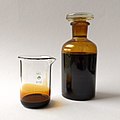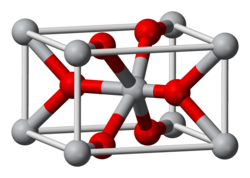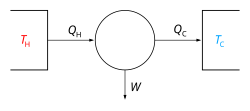An element–reaction–product table is used to find coefficients while balancing an equation representing a chemical reaction. Coefficients represent moles...
2 KB (263 words) - 12:07, 27 June 2025
02), a reference to the 6.02 or 6.022 part of the constant. Element–reactant–product table Faraday constant – Physical constant: Electric charge of one...
29 KB (3,714 words) - 16:30, 13 June 2025
Lead (redirect from Element 82)
Lead (/lɛd/ ) is a chemical element; it has symbol Pb (from Latin plumbum) and atomic number 82. It is a heavy metal that is denser than most common materials...
179 KB (19,075 words) - 02:40, 13 July 2025
Chlorine (redirect from Element 17)
chemical element; it has symbol Cl and atomic number 17. The second-lightest of the halogens, it appears between fluorine and bromine in the periodic table and...
117 KB (13,093 words) - 07:51, 19 July 2025
Transition metal (redirect from Transition element)
the periodic table In chemistry, a transition metal (or transition element) is a chemical element in the d-block of the periodic table (groups 3 to 12)...
40 KB (4,499 words) - 10:03, 18 July 2025
Period 2 in the periodic table A period 2 element is one of the chemical elements in the second row (or period) of the periodic table of the chemical elements...
35 KB (3,913 words) - 17:51, 17 July 2025
the amounts of the separate reactants are known, then the amount of the product can be calculated. Conversely, if one reactant has a known quantity and the...
26 KB (3,391 words) - 00:34, 6 July 2025
Nuclear fusion (section Element synthesis)
form a larger nuclei, nuclei/neutron by-products. The difference in mass between the reactants and products is manifested as either the release or absorption...
113 KB (12,226 words) - 04:19, 17 July 2025
chemical reaction, chemical equilibrium is the state in which both the reactants and products are present in concentrations which have no further tendency to...
44 KB (6,727 words) - 11:35, 24 June 2025
reaction in which two or more products are formed from a single reactant. Contrast chemical synthesis. chemical element See element. chemical formula Any of...
175 KB (19,569 words) - 02:00, 18 May 2025
the concentration of one or another reactant. Reactions whose rate depends only on the concentration of one reactant (known as first-order reactions) consequently...
17 KB (2,586 words) - 14:56, 16 May 2025
Chemical reaction (redirect from Chemical reactant)
are called reactants or reagents. Chemical reactions are usually characterized by a chemical change, and they yield one or more products, which usually...
66 KB (8,048 words) - 01:14, 16 June 2025
the rate of reaction will be proportional to the concentration of the reactant. Thus the concentration will decrease exponentially. [ A ] = [ A ] 0 exp...
17 KB (2,175 words) - 05:07, 18 April 2025
majority of ALD reactions use two chemicals called precursors (also called "reactants"). These precursors react with the surface of a material one at a time...
65 KB (7,443 words) - 09:49, 30 June 2025
Biogenic substance (redirect from Biogenic element)
effectively producing Ag metallic particles, while L. culinaris is an effective reactant for manufacturing Au nanoparticles. This process can also be further adjusted...
32 KB (3,360 words) - 12:30, 2 March 2025
diverse in terms of stoichiometries (the measurable relationship between reactants and chemical equations of an equation or reaction) and in terms of the...
12 KB (1,544 words) - 13:43, 23 July 2025
volume, and the resulting product or products—if gases—also bear a simple proportion by volume to the volumes of the reactants. In other words, gases under...
158 KB (19,509 words) - 03:06, 28 July 2025
Isotopes of hydrogen (category Lists of isotopes by element)
radioactive tracer. Deuterium–tritium fusion uses 2H and 3H as its main reactants, giving energy through the loss of mass when the two nuclei collide and...
16 KB (1,902 words) - 02:24, 25 July 2025
enthalpies of formation of reactants and products using Hess's law. A given reaction is considered as the decomposition of all reactants into elements in their...
29 KB (1,879 words) - 21:49, 30 April 2025
Silicon compounds (category Chemical compounds by element)
2 Mg 2Si + 2 H 2SO 4 → 2 MgSO 4 + SiH 4 Products often vary with the stoichiometry of the silicide reactant. For example, Ca 2Si is polar and non-conducting...
42 KB (5,608 words) - 15:41, 6 February 2025
a product and a more tightly bound element than slightly heavier elements. Both processes produce energy as the sum of the masses of the products is...
52 KB (7,079 words) - 02:14, 17 July 2025
phases. Density measurements indicate a contraction of the product compared to reactants, similarly indicating ionic bonding within the phase. X-ray...
37 KB (3,716 words) - 05:59, 25 July 2025
Nitrifying bacteria (section Table of characteristics)
a complex process that requires several enzymes as well as oxygen as a reactant. The key enzymes necessary for releasing energy during oxidation of ammonia...
14 KB (1,387 words) - 10:11, 25 May 2025
cryogens. Solids are typically prepared using tube furnaces, the reactants and products being sealed in containers, often made of fused silica (amorphous...
30 KB (3,224 words) - 05:34, 24 June 2025
reaction is the enthalpy change when reactants in their standard states (p = 1 bar; usually T = 298 K) change to products in their standard states. This quantity...
48 KB (6,108 words) - 20:45, 18 July 2025
fusion. Moreover, since both reactants need to be mixed together to fuse, reactions between nuclei of the same reactant will occur, and the D–D reaction...
67 KB (7,533 words) - 17:59, 17 July 2025
where at least one change in spin state occurs when progressing from reactant to product. Chemistry portal Physics portal Atomic physics Computational chemistry...
20 KB (2,260 words) - 13:17, 23 May 2025
reactions. Chemical equations make use of the standard molar entropy of reactants and products to find the standard entropy of reaction: Δ S ∘ r x n = S p r o...
5 KB (788 words) - 11:29, 10 February 2025

















